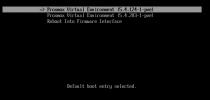Hi there, I have discovered that one of my PCI cards is not compatible with 5.4.73-1-pve. A big thanks to whomever decided to preserve old kernels! I can manually at boot go back and select the kernel version working with my hardware (5.3.18-3-pve) however I have not figured out to make this kernel the new default kernel at reboot. I cannot always access the console and would like to reset it permanently to automatically boot to 5.3.18-3-pve.
I tried to add it to the manual configuration:
and "tried" to remove the old kernel using both
and
The boot-tool command failed because I am learning it only applies to manually added kernels
the purge command removed the 5.3.18-3-pve from my automatic list instead of the 5.4.73 which I really dont understand.
Currently my system looks like this:
But upon reboot unless I explicitly select advanced options and the 5.3 kernel at the console I am still booted into the new 5.4 kernel.
I am using Bare Metal ZFS Mirrored Disks for rpool thus I believe systemd-boot for bootloading
Is there a way to get the system to reboot into the 5.3.18-3 kernel automatically?
I tried to add it to the manual configuration:
Code:
pve-efiboot-tool kernel add 5.3.18-3-pve
pve-efiboot-tool refreshand "tried" to remove the old kernel using both
Code:
pve-efiboot-tool kernel remove 5.4.73-1-pve
Code:
apt purge pve-kernel-5.4.73-1-pveThe boot-tool command failed because I am learning it only applies to manually added kernels
the purge command removed the 5.3.18-3-pve from my automatic list instead of the 5.4.73 which I really dont understand.
Currently my system looks like this:
Code:
pve-efiboot-tool kernel list
Manually selected kernels:
5.3.18-3-pve
Automatically selected kernels:
5.4.73-1-pve
uname -a
Linux <hostname> 5.3.18-3-pve #1 SMP PVE 5.3.18-3 (Tue, 17 Mar 2020 16:33:19 +0100) x86_64 GNU/LinuxI am using Bare Metal ZFS Mirrored Disks for rpool thus I believe systemd-boot for bootloading
Is there a way to get the system to reboot into the 5.3.18-3 kernel automatically?


